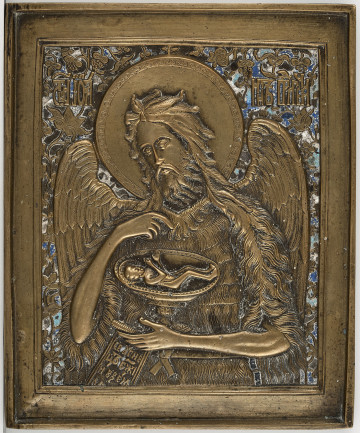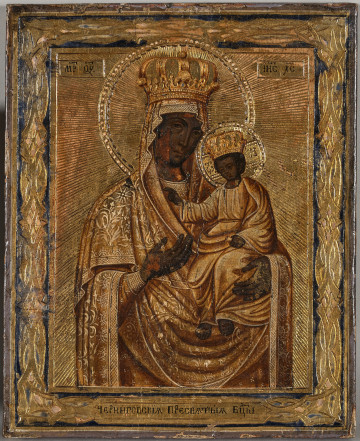
St. John the Baptist
20th century
Castle Museum in Łańcut
Part of the collection: Icons
The Feast of the Exaltation of the Holy Cross is one of the Twelve Great Feasts of the liturgical year in Eastern Christianity, celebrated on the 27th of September (14th of September in the Julian calendar). The origin of the feast was the custom of displaying the cross to the faithful gathered at mass which was adopted in the 4th c. The feast was established to commemorate the discovery of the wood of the True Cross, on which Christ was crucified, at the foot of Golgotha in Jerusalem. This was accomplished by the mother of Emperor Constantine the Great - St. Helena, together with Patriarch Macarius of Jerusalem in 326. The earliest mentions of this event appeared in the writings of St. Ambrose of Milan, towards the end of the 4th c. In later traditions, many of the details about the Cross come from non-canonical apocrypha. The wood of the True Cross, the most important relic for Christians, was to be divided into parts. One of the parts was placed in the Church of the Holy Sepulchre in Jerusalem, which was consecrated on the 13th of September 335 and already on the 14th of September, the Feast of the Exaltation of the Holy Cross was celebrated there for the first time. In 614, during the capture of Jerusalem by Chosroes II, the Persians demolished the temple and looted the relics. Having defeated the Persians, the Byzantine emperor Heraclius recovered the relics and reverentially brought them to Jerusalem. Legend has it, that the ruler took off his rich robes and walked barefoot from the Golden Gate to the temple rebuilt after the destruction. A fragment of the Cross was supposed to be brought to Constantinople by St. Helena, together with the nails she found - the nails which were used to crucify Christ. Historical figures appear in the icons depicting the Exaltation of the Holy Cross. The cross is raised by Bishop Macarius, who stands on a pedestal; it is revered by Emperor Constantine and his mother, Helen, as well as by the community of the faithful. In the lands of old Rus, where the iconostasis - the multi-panel altar barrier separating the sanctuary from the nave - developed, the icon depicting this feast is placed in the Feasts tier. Teresa Bagińska-Żurawska https://orcid.org/0000-0002-9243-3967
Dimensions
height: 30.5 cm, width: 26.5 cm
Object type
Icons
Technique
gilding, tempera
Material
gold, tempera, wood
Origin / acquisition method
decyzja administracyjna
Creation time / dating
Creation / finding place
Owner
Castle Museum in Łańcut
Identification number
Location / status

20th century
Castle Museum in Łańcut

19th (?) century
Castle Museum in Łańcut

1800 — 1850
Castle Museum in Łańcut
DISCOVER this TOPIC
Museum of King Jan III's Palace at Wilanów
DISCOVER this PATH
Educational path